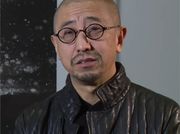Contemporary Chinese artist Zhang Yu is known for his paintings, sculptures, installations, and performances that expand the medium of ink beyond traditional Chinese ink painting.
Read MoreAlongside his art practice, he is closely involved with contemporary Chinese arts communities, edits publications, and curates shows. He lives and works in Beijing.
Graduating from the Tianjin Academy of Arts and Crafts in 1988, Zhang initially made figurative paintings on fan-shaped rice paper, such as a figure before a shrine in A Sacred Place (1987), or the female nude in Modern Lady Figure (1987).
In the early 1990s, the artist participated in an emerging discourse that interrogated ways of experimenting with and recontextualising traditional Chinese ink art, bringing a medium of the past into the present. Seeking to create a new form of non-figuration, in 1991 instead of a traditional paintbrush he used his right index finger to apply dry ink to paper. Paintings of his made with this method often are comprised of small dots that spread across the composition. He emphasises action over abstraction in these 'Fingerprint' paintings.
In Zhang's ink series 'Divine Light' (1994–2003), which consists of monochrome artworks on paper, ink has dried to form textures that range from soft to cracking. Common compositions include a halo engulfing a circle, such as Divine Light Series No. 59, The Floating Incomplete Circle (1998). Stacks of ink-wash bands in Divine Light 2000-8 (2000) evoke traditional Chinese rock paintings.
Zhang's extension of traditional ink painting continued in 2016 in the performance and installation Ascending at Alisan Fine Arts, Hong Kong, for which he replaced the paintbrush with teapots and ink with tea, placing rows of bowls on eight pieces of Xuan paper and pouring pu'er tea into them. As the tea overflowed from the bowls onto the paper, it left behind reddish-brown stains. Other experimental ink paintings include stamping fingerprints on found or unorthodox materials, such as readymade water bottles in Bottle Filled with Fingerprints 5-20190715 (2019) or a piece of Himalayan jade in A Jade Brick Printed with Fingerprints 20190617 (2019).
Zhang has garnered international attention, especially in American in 2013 when works from his 'Divine Light' series appeared in the group exhibition Ink Art: Past as Present in Contemporary China at The Metropolitan Museum of Art in New York.
He has also held numerous solo exhibitions, among them Fingerprints: Boundaries of Time and Truth, Alisan Fine Arts, Hong Kong (2019); Zhang Yu: The Form of Notion/Thought, Guangdong Museum of Art (2014); and Cultivation Practice: Exhibition of Zhang Yu's Fingerprint Works 1991–2013, Gwangju Museum of Art (2013).
His work is also held in private and public collections.
Ocula | 2019




